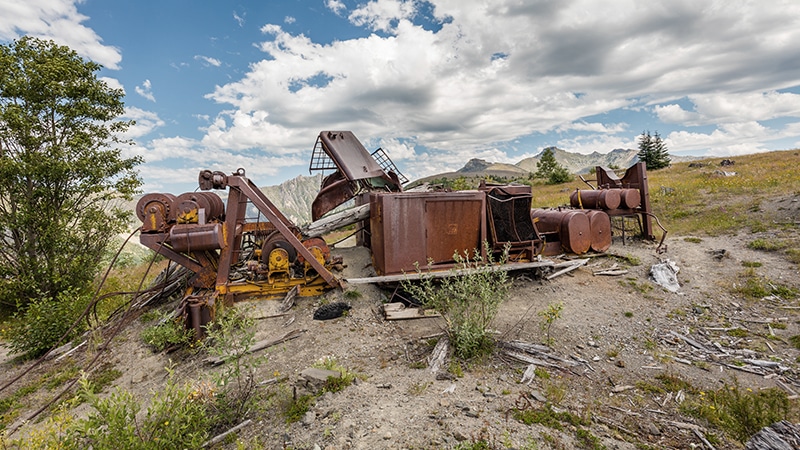
About This Project

Sheridan, OR – BOS 100® Injection
The subject property formerly operated as the Retail and Commercial Farm facility. The facility formerly stored and sold feed, farm equipment, and various farming chemicals (fertilizers, herbicides, and pesticides, etc.). In 2015, prior to the potential sale of the property, a Phase I Environmental Site Assessment (ESA) and subsequent Phase II ESA were undertaken. The Phase II ESA identified elevated concentrations of carbon tetrachloride, ethylene dichloride (1,2-Dichloroethane [EDC]), and chloroform in the area of the former Grain Elevator structure on-site.
Carbon tetrachloride: Carbon tetrachloride was used in the manufacturing of refrigerants and propellants for aerosol cans; as a solvent for oils, fats, lacquers, varnishes, and rubber waxes; in fire extinguishers and resins; and as a grain fumigant and dry cleaning agent. Because of its harmful effects, its use in consumer products was banned in the 1970’s, and today is only used in some industrial applications. EDC (also known as 1,2-dichloreothane) is primarily used in the production of vinyl chloride and other chemicals, but was added to leaded gasoline as a lead scavenger, and also used as a grain fumigant. Several studies have found that reductive dechlorination of carbon tetrachloride produces in order, chloroform, dichloromethane, and methyl chloride.
RDC Soil and Groundwater Sampling
Additional characterization with respect to the mass and magnitude of residual soil and groundwater contamination was assessed through the installation of 11 push probes, four (4) of which were also completed as permanent monitoring wells. A total of 90 soil and 11 groundwater samples were collected to facilitate calculation of total contaminant mass in soil and groundwater and refine a preliminary BOS 100® injection design.
BOS 100® Injection
In February 2016, interim corrective action was implemented involving the injection of BOS 100®, a slurry of water and conditioned activated carbon impregnated with zero valent iron, into the area of source contamination located between 10 and 18 feet BLS (i.e., saturated zone). The targeted areas for injection of the BOS 100® slurry included: areas of known elevated carbon tetrachloride, chloroform, and EDC, defined by push-probes P5 and P18; and all upgradient and downgradient areas identified as having lower residual “like” contamination. The dosing of BOS 100® in the area targeted for treatment was based upon the analytical soil and groundwater data obtained from the RDC investigation. Treatment at the site consisted of three (3) target areas of varying BOS 100® dosage. The injection work included a total of 87 injection points, on an alternating seven and one-half (7.5) foot triangular grid. Based upon calculations of residual mass and adsorption isotherms, 10-17.5 pounds of BOS-100® were injected per injection horizon.
Post-Injection Compliance Monitoring
Three (3) post injection groundwater monitoring events have been completed from four (4) site monitoring wells. Contaminants of concern have shown significant decreases in concentration since in-situ treatment via injection of BOS 100®. Further, there is specific evidence of continued contaminant degradation, based on dissolved methane detected in groundwater from monitoring wells MW2 and MW4.
A risk-based comparison of detected contaminant concentrations in groundwater to applicable RBCs do not identify any contaminants in groundwater currently exceeding applicable risk-based concentrations (RBCs). The injection of BOS 100® appears to have successfully reduced contaminant concentrations in the source area, as well as those areas hydraulically connected to the source area. Based on the findings post injection groundwater monitoring events, one (1) additional post-treatment groundwater monitoring event is proposed prior to recommending site closure.
| Pre- and Post Injection Groundwater Analytical Results
Sheridan, OR ND<0.05) Indicates contaminant not detected above method-reporting limit indicated. All other laboratory analyses conducted by Apex Laboratories in Tigard, Oregon. RPI: (Remediation Products Inc.) in Denver, Colorado Highlighted concentrations indicate value exceeding one or more of reasonably applicable risk-based concentrations (RBCs). |
|||||
| Sample Location | Sampling Date | Carbon Tetrachloride | Chloroform | EDC | Methane (by RPI) |
| MW1 | 11/02/15 (RPI) | 65,500 | 3,190 | 8,850 | no analysis |
| 2/25/16 (RPI) | 291 | 690 | 128 | no analysis | |
| 4/11/16 | 299 | 860 | 137 | ND (<1.0) | |
| 7/06/16 | 684 | 887 | 169 | 34.3 | |
| 10/05/16 | 91.6 | 392 | 115 | ND (<1.0) | |
| MW2 | 11/02/15 (RPI) | 3.74 | 2.28 | 650 E | no analysis |
| 2/25/16 (RPI) | ND (<0.5) | 0.84 | 2.84 | no analysis | |
| 4/11/16 | ND (<1.0) | 0.52 | 5.12 | ND (<1.0) | |
| 7/06/16 | ND (<1.0) | ND (<1.0) | 13.2 | 59 | |
| 10/05/16 | ND (<1.0) | ND (<1.0) | 12.1 | 63.1 | |
| MW3 | 11/02/15 (RPI) | 105 | 169 | 674 E | no analysis |
| 2/25/16 (RPI) | ND (<0.5) | 22.3 | 19.4 | no analysis | |
| 4/11/16 | ND (<1.0) | 17.1 | 13.3 | ND (<1.0) | |
| 7/06/16 | ND (<1.0) | 14.3 | 9.09 | 17.1 | |
| 10/05/16 | ND (<1.0) | 4.41 | 8.48 | ND (<1.0) | |
| MW4 | 11/02/15 (RPI) | ND (<0.5) | 1.19 | 146 | no analysis |
| 2/25/16 (RPI) | Not Sampled | Not Sampled | Not Sampled | no analysis | |
| 4/11/16 | ND (<1.0) | ND (<0.5) | 1.42 | ND (<1.0) | |
| 7/06/16 | ND (<1.0) | ND (<1.0) | 1.94 | 38.1 | |
| 10/05/16 | ND (<1.0) | ND (<1.0) | 3.31 | 50.2 | |
| Groundwater in an Excavation | 1,800 | 720 | 630 | Degradation | |
| Occupational Vapor Intrusion into Buildings | 1,200 | 1,600 | 3,900 | Product | |
| Occupational Volatilization to Outdoor Air | 7,700 | 6,300 | 9,000 | (No RBC) | |

